The Currency of Power: In the mid-1980s many commentators predicted the end of the role of military force as the “currency of power”. Subsequent decades were however marked by global changes that significantly altered the distribution of international power. Radical shifts in the status of erstwhile subjugated states, the empowerment of newly developed and developing nations, and the displacement of totalitarian regimes across Europe, have altered the perception of the influence of military power in determining the course of global events. The freeing up of economies, which became the norm by the mid-1990s, resulted in a rise in expectations in many parts of the world.
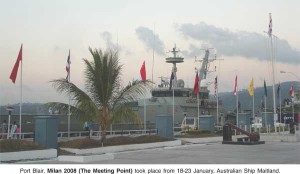 The spread of information made the disparities in living standards more glaring and national, political or ethnic groupings became assertive of their right to a share of the global wealth. As changing tectonic conditions result in periodic earthquakes which enable the earth’s crust to adjust to the altered conditions, this instability created violent upheavals involving the use of military force to realign political or economic power. Predictions of the demise of military force as a currency of power were thus belied by the unilateral exercise of the military option in Central Europe and in West Asia. Far from the imagined era of stability (which is largely interpreted as the maintenance of the status quo) and the much vaunted “end of history” theory, the last two decades have been the most violent in history.
The spread of information made the disparities in living standards more glaring and national, political or ethnic groupings became assertive of their right to a share of the global wealth. As changing tectonic conditions result in periodic earthquakes which enable the earth’s crust to adjust to the altered conditions, this instability created violent upheavals involving the use of military force to realign political or economic power. Predictions of the demise of military force as a currency of power were thus belied by the unilateral exercise of the military option in Central Europe and in West Asia. Far from the imagined era of stability (which is largely interpreted as the maintenance of the status quo) and the much vaunted “end of history” theory, the last two decades have been the most violent in history.
Apart from its being used as a means of forcibly redistributing political power within and between nations, military power is also being applied to further economic interests. The attack on Iraq by the US, and the current imbroglio in that unhappy country, had as much to do with the perceived energy requirements of the US as with any real or imaginary weapons of mass destruction. Similarly, it has been argued that Iraq’s plans to trade its oil wealth in euros threatened the primacy of the dollar as the global currency, and the attack on Iraq was a measure to safeguard vital US economic interests.
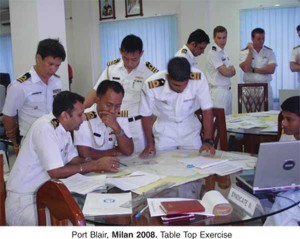 It is apparent therefore, that far from becoming irrelevant, or even waning in importance, military power is still considered a legitimate and viable option by countries that wish to impose their vision of the international order on recalcitrant lesser states. It is equally an unavoidable conclusion that states that wish to retain their freedom of manoevre in global affairs, must possess a sound economy, backed by a robust (even if defensive) military capability. Clearly the age has not yet arrived when nations can dispense with their armed forces. If anything, recent events would indicate the opposite – that failure to invest in national defence capability could cost a country dear.
It is apparent therefore, that far from becoming irrelevant, or even waning in importance, military power is still considered a legitimate and viable option by countries that wish to impose their vision of the international order on recalcitrant lesser states. It is equally an unavoidable conclusion that states that wish to retain their freedom of manoevre in global affairs, must possess a sound economy, backed by a robust (even if defensive) military capability. Clearly the age has not yet arrived when nations can dispense with their armed forces. If anything, recent events would indicate the opposite – that failure to invest in national defence capability could cost a country dear.
The Nature of Future Wars
While it is fairly clear that nation states will continue to resort to military force, and we will need to maintain armed forces for the foreseeable future, it is much less clear, what size and shape and capabilities those forces will need to have. Warfare has begun to evolve away from the historical pattern, and massive wars on a global scale between evenly matched and industrialised opponents are generally accepted to be a phenomena of the past. Major influences on the nature of future warfare will be exerted by three main factors–economic interdependence and global-isation, redistribution and realignments of international power, and technology.
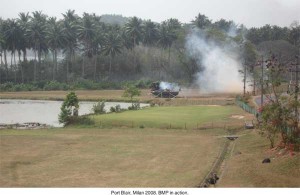 With the collapse of the USSR, socialist economic doctrines were rapidly discarded by all countries and they have embraced the free market philosophies of the West. The resultant free flow of capital, the increase in global movement of labour, and the offshoring of industrial production have bound countries together in a variety of ways–economic, social and cultural. It would be impossible under these conditions for a country to inflict severe or lasting damage to another with which it has close economic ties without itself suffering in the process. Globalisation has thus curtailed the freedom of the more powerful nations to act with impunity against weaker nations with well-developed economies, and with which they have economic relationships. The nature of conflict between such countries would necessarily be of brief durations and be focused on the achievement of narrow and specific (mainly economic) objectives.
With the collapse of the USSR, socialist economic doctrines were rapidly discarded by all countries and they have embraced the free market philosophies of the West. The resultant free flow of capital, the increase in global movement of labour, and the offshoring of industrial production have bound countries together in a variety of ways–economic, social and cultural. It would be impossible under these conditions for a country to inflict severe or lasting damage to another with which it has close economic ties without itself suffering in the process. Globalisation has thus curtailed the freedom of the more powerful nations to act with impunity against weaker nations with well-developed economies, and with which they have economic relationships. The nature of conflict between such countries would necessarily be of brief durations and be focused on the achievement of narrow and specific (mainly economic) objectives.
The changed distribution and alignment of international power has various facets. The US, and under its leadership NATO, have resorted to military actions decisively against several countries in the last two decades. The object states of these actions are countries that are characterised by poor economic levels, political instability, and the absence of democratic forms of government. It is hard to see similar actions being taken against countries with a stable and democratic system in place, and which have well developed economic, social and cultural international linkages. Although the US has emerged as the sole superpower, it has been forced to become increasingly heedful to international opinion. Thus, while the end of the Cold War resulted in the emergence of a single super power, the economic globalisation that followed has swung the pendulum slightly back, resulting in a moderation of the superpower status.
The resultant free flow of capital, the increase in global movement of labour, and the offshoring of industrial production have bound countries together in a variety of ways”“economic, social and cultural. It would be impossible under these conditions for a country to inflict severe or lasting damage to another with which it has close economic ties without itself suffering in the process.
The spread of satellite television brought distant wars to the homes of viewers, and the developed countries are finding it increasingly difficult to justify the loss of human life. The political cost of casualties in war has increased to the point where risk avoidance has become an important factor that impinges on war tactics in Western countries.
- These factors permit the following conclusions:
- Wars of the future are likely to brief and focused on economic objectives.
- They will be more in the nature of specific operations against unequal and weak states with poorly developed and insular economic and political systems.
- They will not be waged with equally industrialised or advanced countries.
- They will be increasingly subject to world opinion and approval.
- Risk avoidance will result in the use of long range weapons and aerial bombardment with precision weapons.
The Revolution in Military Affairs
The factors discussed above will have a profound effect on the framework and rules by which wars will be fought. They will determine under what circumstances nations, even powerful ones, will resort to military action against other states, and with the passage of time, will increasingly circumscribe the kind of targets that will be acceptable for attack. In contrast, the third factor, i.e. technology, will have its greatest impact on the means and methods in which future wars will be fought, and on the weapon systems and platforms of military and naval forces.
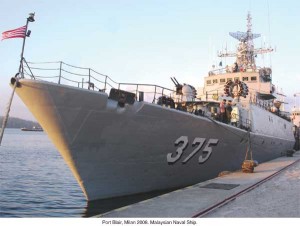 In the mid-1990s it was realised that the rapid growth of information technology and digital communications made possible the transmission of huge amounts of battle theatre data in real time. This happened at a time when the demise of the Soviet Union suddenly knocked out the core of the US Navy’s strategy, which was centred on tracking, outmaneuvering and pre-empting the Russian forces at sea. The US Navy was quick to recognise the need to shift its strategy to one based on joint operations with other forces, on and over land. This shift was only possible because of the emergence of technology to back it up.
In the mid-1990s it was realised that the rapid growth of information technology and digital communications made possible the transmission of huge amounts of battle theatre data in real time. This happened at a time when the demise of the Soviet Union suddenly knocked out the core of the US Navy’s strategy, which was centred on tracking, outmaneuvering and pre-empting the Russian forces at sea. The US Navy was quick to recognise the need to shift its strategy to one based on joint operations with other forces, on and over land. This shift was only possible because of the emergence of technology to back it up.
The new concept of operations is based on data being uploaded on to a network which can be accessed by all combatant commanders, and the scenario perceived by individual units can be integrated in real time to give all commanders a total perspective on the overall operational scenario.
Notwithstanding these areas of uncertainty, it seems inevitable that net-based war or network-centric warfare is the way naval warfare is headed, and our planners and designers will have to factor this into their template for the Navy of the future.
It has thus become possible for a unit to bring to bear its fire power on a target, even if it does not even have it on its radar or other sensors. Western military scholars define a revolution in military affairs as a rapid change in the warfare paradigm brought about by technology or new concepts, which are usually accompanied by new organisational structures.
Unlike earlier such revolutions in naval warfare in the past such as the advent of steam, the invention of the submarine, the invention of the radar, the development of the aircraft carrier and nuclear power, the current RMA is different in that it is likely to affect not only one service and its combat methods, but will have its impact on all armed forces and their operational doctrines.
The Future Navy
Specifically for the Navy, the current RMA will impinge on one of its basic traditional characteristics – the isolation of the naval commander at sea and the corresponding degree of freedom he had to make operational and tactical decisions. The published opinion is that the new scenario will enable rapid dissemination of operational information and decentralise decision-making, but there is another aspect which may have the opposite effect; the operational commander’s superior too will have the total picture and will in a sense be alongside the fleet commander, which will considerably curtail his initiative!
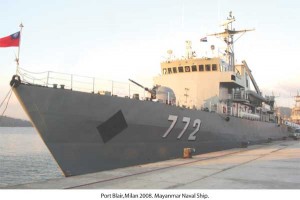 Notwithstanding these areas of uncertainty, it seems inevitable that net-based war or network-centric warfare is the way naval warfare is headed, and our planners and designers will have to factor this into their template for the Navy of the future. The US and NATO have recognised this and have embarked seriously on a programme of “transformation” of their Navies to make them conform to the new roles and warfighting trends. New organisations have been set up with the specific task of conceptualizing and implementing the process of transformation and many decisions have already been taken to make the force structure of the future navy correspond to its predicted role and missions.
Notwithstanding these areas of uncertainty, it seems inevitable that net-based war or network-centric warfare is the way naval warfare is headed, and our planners and designers will have to factor this into their template for the Navy of the future. The US and NATO have recognised this and have embarked seriously on a programme of “transformation” of their Navies to make them conform to the new roles and warfighting trends. New organisations have been set up with the specific task of conceptualizing and implementing the process of transformation and many decisions have already been taken to make the force structure of the future navy correspond to its predicted role and missions.
It goes without saying that the strategic imperatives of all countries vary, and notwithstanding recent writings and pro-nouncements about shared strategic interests and natural strategic partners, those of the US and Western powers are bound to be at divergence with several aspects of our own strategic perceptions. It is necessary for the current trends to be seen through the prism of national self-interest, and to make plans for the future structure of the Navy accordingly. One fact does seem evident – there is a need for transforming the Navy to one that will meet our requirements of the future.
It is interesting to observe that in the US context, two of the most ship innovative design decisions, the Littoral Control Ship and the conversion of the Ohio class, were thrust from above upon the US Navy. The Indian scene is different, and the Navy will have to wage a long struggle to get approval for its every proposal.
The Indian Navy has no time to lose in instituting such a process. The concept of network-centric warfare has already been studied for several years, but the task of making the navy of the future capable of it has to be addressed now if the current discourse is not to remain an academic one. A few major thrust areas could be:
- Design and production of an indigenous net platform on which the network-centric operations will be based. This would have two or three versions with differing capabilities for different classes of ships.
- Commonalisation of procedures between the Air Force and the Navy to enable joint operations followed by standardization of communication and sensor systems for networking compatibility.
- Reduction in the number of types of warships, to reduce logistic complexity and improve ship availability. The Quadrennial Defence Review of 2006 for the US Navy envisages four types of ships for a total of 143 major surface combatants. In contrast, the 21 principal surface combatants we have in the Navy today belong to seven different types.
- Institution of a programme for integration of the submarine force into the network; this will require a major effort to equip submarines with real time communication systems with minimal loss of stealth. It will also require a changed mindset in the operating philosophy of submarines wherein submarines are given the minimum essential operational intelligence and directives before deployment and thereafter left pretty much to themselves for the duration of hostilities.
- Institution of a development programme for precision guided weapons.
- Development of a modern and interoperable radar system network between all combatant units.
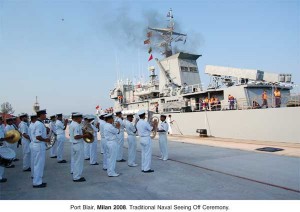 This is probably a minimalist approach, and it has not considered the major efforts required in associated areas, particularly in education and training. But the point to be emphasised is an often-stated truism: it takes a lifetime to build a Navy, and if we are to transform the Navy of today into one that meets the task of (say) 2025, then the time to act is already upon us. It is interesting to observe that in the US context, two of the most ship innovative design decisions, the Littoral Control Ship and the conversion of the Ohio class, were thrust from above upon the US Navy.
This is probably a minimalist approach, and it has not considered the major efforts required in associated areas, particularly in education and training. But the point to be emphasised is an often-stated truism: it takes a lifetime to build a Navy, and if we are to transform the Navy of today into one that meets the task of (say) 2025, then the time to act is already upon us. It is interesting to observe that in the US context, two of the most ship innovative design decisions, the Littoral Control Ship and the conversion of the Ohio class, were thrust from above upon the US Navy.
The Indian scene is different, and the Navy will have to wage a long struggle to get approval for its every proposal. The scenario is complicated by the fact that technology is advancing at an exponential rate, and this increases the cost of upgradations, and brings in its wake the spectre of rapid obsolescence.
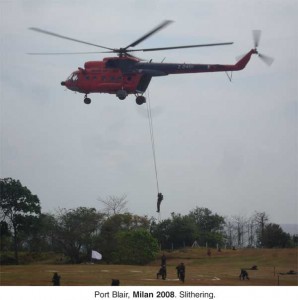 The preparation of a blueprint for the future Navy, the setting in motion of the development of the technologies required, and the steering of the concept and its implementation will require a dedicated organisation at a high level. Such an organisation will need to study the problem in a comprehensive manner, and cover the entire range of issues from the analysis of technology to finance and design, construction and training. More importantly they will have to convince the Government and many within the Service itself of not only the need, but also the urgency of such measures.
The preparation of a blueprint for the future Navy, the setting in motion of the development of the technologies required, and the steering of the concept and its implementation will require a dedicated organisation at a high level. Such an organisation will need to study the problem in a comprehensive manner, and cover the entire range of issues from the analysis of technology to finance and design, construction and training. More importantly they will have to convince the Government and many within the Service itself of not only the need, but also the urgency of such measures.
Conclusion
Modernisation of warfare strategies and techniques, and adoption of technologically advanced concepts are futile exercises if the basic structure of the Navy is not given the timely attention that is due. The creation of a balanced maritime defence force is an essential aspect of any modernisation, and the shortfall in our fleet units and submarines has to be made good by the political commitment to a sustained building programme rather than by sporadic inductions.
In conclusion it needs to be said that the entire premise in this article has been that the equipment and system needed for net-based warfare will be developed and built in India, as dependence on foreign sources for such crucial systems will create an unacceptable vulnerability.
It has also been based on the hope that the process of production and acquisition and for obtaining government approvals will also be modernised along with the equipment and systems for the armed forces.




